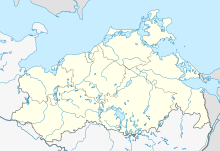Wostevitzer Teiche nature reserve
Coordinates: 54 ° 29 ′ 23.2 " N , 13 ° 33 ′ 13.3" E
The Wostevitzer Teiche nature reserve is a nature reserve in Mecklenburg-Western Pomerania six kilometers southwest of Sassnitz and immediately south of the Mukran ferry complex . The eponymous place Wostevitz is north. The area is divided into the Large and Small Wostevitz Pond and the surrounding siltation zones.
The 322 hectare area was designated on August 26, 1994 with the aim of preserving two shallow lakes and the surrounding reed beds, reeds and swamp forests, as they are home to a rich amphibian and bird fauna . The condition of the swamp forests and reeds is considered to be good, while the condition of the reed beds and water bodies is unsatisfactory due to nutrient inputs. The nature reserve is protected under EU law as a part of the bird sanctuary in the Binnenbodden von Rügen . The area can be entered on the southern edge via a dirt road. Part of the area has been owned by the NABU Foundation for National Natural Heritage since 2009 .
History and water balance
Today's Wostevitz ponds were created during the last glaciation and are located in a ground moraine landscape . Presumably they go back to leftover dead ice . The water depth of the lakes is shallow and in the following time they silted up as swamp bogs up to two meters thick . It is worth mentioning that the Wostevitz ponds are one of the few lakes on Rügen that never had a connection to the Baltic Sea. The current state of the lakes is classified as polytrophic . The Great Wostevitz Pond drains over the Saiser Bach into the Little Jasmunder Bodden to the south .
Human use has been documented for the areas for centuries. The Swedish matriculation card shows the entire area free from forests. A quarry forest can only be seen in the northwestern part of the Kleiner Wostevitz Pond . Around the lakes there were meadows and pastures at that time . In the 19th century the siltation of the lake increased and swamp forests grew and soon enclosed the shore together with reed beds. During the GDR era , the condition of the lakes was worsened by the introduction of pig manure, so that shortly afterwards the visibility was only 20 centimeters.
Flora and fauna
Until the beginning of the 1970s, the Wostevitz ponds had rich underwater and floating leaf vegetation and surrounding wet meadows with pipe grass , globe flower and cabbage thistle . Typical were mermaid , chandelier algae , spring moss , spawning herbs and crab claws . This has disappeared today and there are only duckweed , reeds and cattails . Numerous types of sedges , bitter foam herb , spring chickweed and the water feather have been identified. Landward follow gray willow , reed beds , Hochstaudenfluren and Erlenbruchwald. There is a rich amphibian fauna in the area with all species typical of the country. Ornithological notable are Corncrakes , harrier , Tüpfelralle , Klein Ralle , tern and Dove . The adder lives in the area. Representatives of the molluscs are the common pond mussel , spring pea mussel and moss bladder snail .
literature
- Wostevitz Ponds 285 . In: Ministry of Environment Mecklenburg-Western Pomerania (Hrsg.): The nature reserves in Mecklenburg-Western Pomerania . Demmler-Verlag, Schwerin 2003, ISBN 3-910150-52-7 , p. 132 f .
Web links
Individual evidence
- ↑ Standard data sheet EU bird sanctuary inland from Rügen (PDF; 96 kB)
- ↑ The first 110 hectares are secured! NABU Foundation for National Natural Heritage, accessed February 9, 2016.
- ↑ Biotope arches Extensive silting areas at the Wostevitz ponds (PDF; 25 kB)



